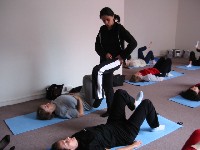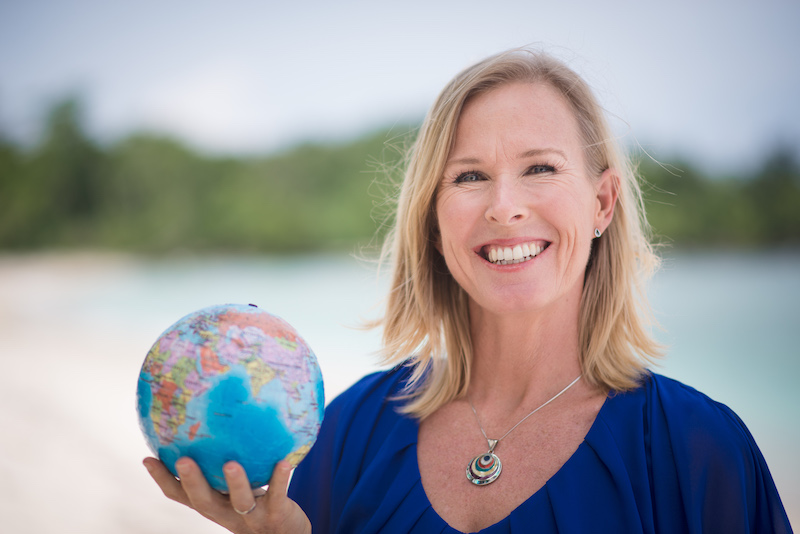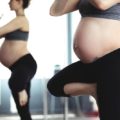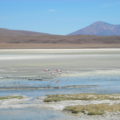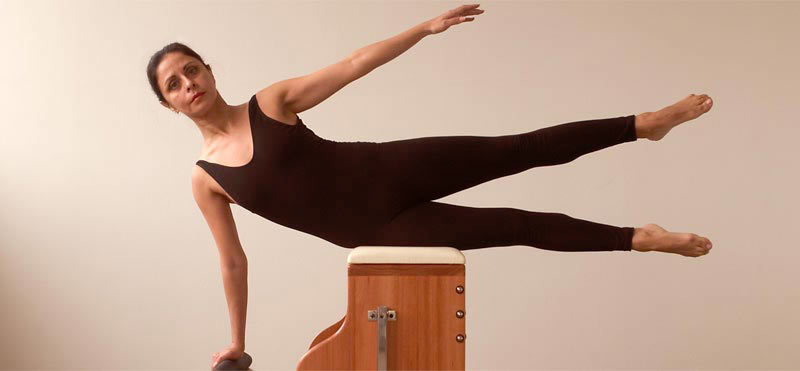
The Pilates method is becoming more and more famous all over the world. It is a form of fitness that people of every age can enjoy. In some countries it has become a real fashion, and a profitable business for many. But what is Pilates method? Where does it come from? What advantages does it offer? Who can teach it? Marissa, an expat Pilates teacher, explains all of this and more. Thank you Marissa!
It is worthwhile to tell you briefly about Marissa’s life, even if only in relation to her Pilates method, what she is presently working with. In fact Marissa has had a long career as classical dancer in the international scene.
Born in Lima, she studied classical dancing first in Peru and then in the Colon Theatre in Buenos Aires. In 1979 she moved to Malmo, Sweden, where she had a very succesfull career as solo dancer, and where she met Helge, her husband, a renowed pianist.
Marissa continued her dance courses in New York and then in London, dividing her time between dancing and studying various areas linked to movement, voice and breathing. In London she was trained as a Pilates teacher, and when she moved back to Lima she was thus able to set up her own Pilates centre, “Pilates Integral”, whom she managed for years, sometimes from far away, before closing it recently, to move to Barcelona permanently.
Joseph Pilates was born in Germany in 1880. A fragile child, suffering from asthma, rachitism and rheumatic fever, Joseph developed a series of exercises that allowed him to alleviate his sufferings.
When he grew up he moved to England, where he worked as a boxer until World War I broke out. He was then sent to Lancaster where he started teaching his friends on the battlefield the method he had developed for himself through the years, and that combined some principles of oriental philosophies (awareness of one own’s body) with those of the Western fitness exercises.
Later he applied this method to help wounded soldiers, at first using the springs of their beds to help them producing resistance and move more easily when laying in bed.
In 1962 Pilates moved to New York, where he continued to use his method, helped by his wife Clara, a professional nurse.
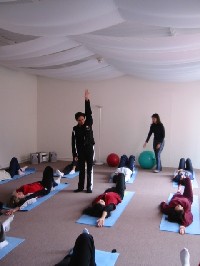 Pilates method is the only really complete method because it makes every single body part work, to improve and strengthen the whole organism, and does not neglect even a single aspect of the process: concentration, breathing control, movement, that must not necessarily be the result of an effort, but rather soft, elastic, sweet.
Pilates method is the only really complete method because it makes every single body part work, to improve and strengthen the whole organism, and does not neglect even a single aspect of the process: concentration, breathing control, movement, that must not necessarily be the result of an effort, but rather soft, elastic, sweet.
Marissa wants to explain immediately a basic concept: the Pilates method cannot be taught to a group of people in the same way, but it must take into account the physical conditions of the single person, and adapt to them.
Applying Pilates exercises indistinctly, intensively and constantly without checking their effect on the person, can even have damaging results. For this reason two things are very important: who gives the Pilates lesson and tailoring the method on the single person.
Indeed Marissa explains that many of the trainers that give Pilates classes presently have not been sufficiently or adequately trained. Actually Pilates has become so popular that it often happens that gym clubs employ teachers that might have a specialization in aerobics and have learnt the method by watching a tape or attending some lessons.
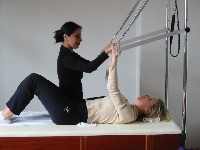 Indeed before being able to give Pilates classes one has to undergo a long training, that includes, besides a very high number of practical hours under the supervision of experts of the method, the study of the human body and its functioning, sessions with physiotherapists, and hours as an assistant in Pilates lessons carried out by already trained teachers. This is not always the case when one goes for a Pilates lesson without being sure of whom is giving it. Marissa tells us that she has taught people who were suffering from damages caused by repeatedly wrong movements during Pilates classes given by participants.
Indeed before being able to give Pilates classes one has to undergo a long training, that includes, besides a very high number of practical hours under the supervision of experts of the method, the study of the human body and its functioning, sessions with physiotherapists, and hours as an assistant in Pilates lessons carried out by already trained teachers. This is not always the case when one goes for a Pilates lesson without being sure of whom is giving it. Marissa tells us that she has taught people who were suffering from damages caused by repeatedly wrong movements during Pilates classes given by participants.
This is why, Marissa repeats, it is very important that, when giving “mat class”, i.e. the group class on the mats, the teacher must always be very careful of the movements and the physical confrontation of the single students, and give them appropriate indications and tools according to their case. During the group class Marissa moves from one student to another, asks whether they suffered from particular problems, helps them with certain movements, gives them a ball or a ribbon to help them to achieve certain movements, prevents them from doing others. The lesson is intense but not tiring. Movements must arrive only where one can, and their aim is explained at every single movement.
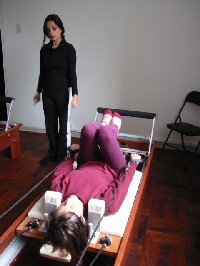 We now move on to talk about the machines that are used to run the whole cycle of the exercises of the Pilates method. They are machines that basically use springs to produce high levels of resistance and therefore require the body to make an effort (according to the various cases) that will be intensified while the organism acquires strength and resilience.
We now move on to talk about the machines that are used to run the whole cycle of the exercises of the Pilates method. They are machines that basically use springs to produce high levels of resistance and therefore require the body to make an effort (according to the various cases) that will be intensified while the organism acquires strength and resilience.
What Marissa always insists upon, both during mat class and on the machines, is that one has to concentrate on the center of the body, that in the Pilates language is called the “powerhouse”, located in the meeting point of the abdomen muscles, and that gives stability and support to the body in all its daily movements – from getting up from the bed to sitting at the table, to walk or run through the park. Concentration and strengthening of this central point has a global beneficial effect that expands naturally to the whole body: the spine assumes the right posture, arms and legs move in a lighter way, the head is no longer heavy.
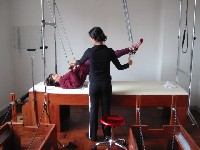 Moreover the fact of using the mind to control the body movements during exercises, and to continually concentrate on the “central point” also develops an awareness of own’s person that helps avoid incorrect postures and to control the distribution of energy and of the effort on the muscles.
Moreover the fact of using the mind to control the body movements during exercises, and to continually concentrate on the “central point” also develops an awareness of own’s person that helps avoid incorrect postures and to control the distribution of energy and of the effort on the muscles.
Try it to believe it!
Claudia Landini (Claudiaexpat)
June 2016
Photos ©Claudiaexpat

